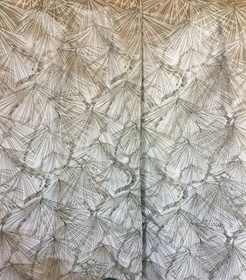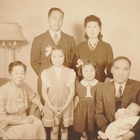Jichan and Bachan brought back many beautiful gifts from their trips to Japan. They ordered lovely, hand-dyed silk kimonos for my mother, my sister Louise, and me, each embellished with the Araki family crest. Beautiful belts (obi) were part of each kimono set. One year, they gave me a gorgeous brocade piece fabric which shimmered with silvery threads.
Growing up with Jichan and Bachan, I learned a complex and loving pattern of customs around gift giving and receiving, an important part of Japanese culture which was retained in America. No one explained it to me. It was simply the proper way to live one’s life. When Jichan and Bachan went on trips to Japan, it was customary for Mother and Father to give them cash gifts for the trip. In return, Jichan and Bachan would spend a large portion of the cash on gifts for Mom, Dad, and us, their grandchildren.
Giving and receiving gifts was an essential part of every important occasion for the Issei and Nisei. Gifts were given and received at births, weddings, deaths (koden), when one recovered from a hospital stay or long illness, and any other of a myriad of important life events. The kinds of gifts chosen, the elegant and complex ways in which the gifts were carefully wrapped, and the skill with which Japanese characters were hand painted with elegant brush strokes on the packages, or displayed on a note insert incorporated into the packaging, were integral elements of the gifts. Cash gifts were inserted into elaborately decorated envelopes with the appropriate kanji, often pre-printed on the envelopes. All the courtesies of thanking people for their gifts (often with another slightly lesser gift,) finding just the right gift for the right person, and giving and receiving gifts in a graceful manner, created a beautiful and thoughtfully woven fabric of friendship and civility.
The Order of the Rising Sun

After Jichan died on December 13, 1975 at the age of 89, Mother told me that he was very proud of an award, in the form of a beautiful pin, that he had received from Japan. He was so proud of it that Mother arranged to have it buried with him. It became important for me to understand why Jichan so treasured his award. I had only an old and rather blurry photograph of Jichan wearing the pin.
From that photograph, I searched the web and with the help of some knowledgeable people, the pin was identified as likely to be the Sixth Class Order of the Rising Sun with Silver Rays. At the same time, I learned the Japanese government had awarded director Clint Eastwood the Order of the Rising Sun with Gold Rays, the third highest level of the eight levels of the Order of the Rising Sun.

I began to understand that any level of award of the Order of the Rising Sun was very prestigious. The Imperial Order of Meiji was established on April 10, 1875 by the Emperor Meiji and was later renamed the Order of the Rising Sun. Jichan was born on October 25, 1886, in the Meiji era, which was from October 23, 1868 to July 30, 1912.
I now believe that Jichan’s mindset was very much that of a man of the Meiji era. In the Meiji era, Japan came out of isolation and transformed into an international, modernized industrial power. Jichan wanted to experience the Western world and to gain knowledge and prosperity in that world when he came to America, alone, in 1906.
On January 9, 2017, I received an email response to my inquiries from Mr. Hiroaki Tojo, the Consulate General of Japan in Seattle, regarding Jichan’s Order of the Rising Sun award. An edited version of Mr. Tojo’s email is included below:
Ms. Yamamura,
Thank you for contacting us. Unfortunately, we no longer have the detailed information of your grandfather’s decoration here at the Consulate. The only information we have is as follows:
Mr. Nisaku Araki, … was decorated in the fall of 1972 (the 47 year of Showa). He was awarded Sixth Class of the Order of the Rising Sun (Kun Roku-to Kyokujitsu Tanko Sho …) now called the Order of the Rising Sun, Silver Rays, (Kyokujitsu Tanko Sho …) in recognition of his contributions in promoting the mutual understanding between Japan and the United States through his role as the President of the Washington State Japanese Greenhouse Guild (I am not sure this is the official translation of his organization. In Japanese, it was called … but we do not have the exact English translation anymore.) Although we think he was 86 years old at the time of his decoration, please check his birth certificate to confirm his age in 1972.
We hope this could be of help to you as you try to complete your family record, and wish you the best for your project.
Sincerely,
Hiro Tojo
Consulate-General of Japan in Seattle
Yukari Yoshida, Araki family members living in Japan, and I have shared family history through an exchange of emails since 2017. My translator, Kota Morikawa, translated Yukari’s letters into English and my letters into Japanese. When informed of Jichan’s award, Yukari kindly provided this information about Jichan’s Order of the Rising Sun Award in an email letter:
…I requested the local government [to send me the detail about Nisaku’s award. The detailed document finally came from the Japanese Ministry of Foreign Affairs.
Name: Nisaku Araki
Birthdate: Year 19 Meiji (1886), 10/25
Award: the Sixth Grade Medal of the Rising Sun of Silver Rays (勲六等単光旭日章)
Date of receipt: Year 47 Showa (1972), 11/3 when he was 88 [86] years old
Reason of receipt: Cultivation of flower and ornamental plants for a long time and contribution to the development of the Japanese community and educating young generations.
Notable Career:
- indoor cultivation of flower and ornamental plants
- Seattle Nikkei Community Councilor
- Committee of Seattle Japanese Language Board of TrusteeA member of the Japanese Ministry of Foreign Affairs working in the U.S. found Nisaku’s contribution and recommended to the Japanese Government for the award.
The letter also informed me that more detail about Nisaku’s award could be found at the Seattle branch of the Japanese Ministry of Foreign Affairs.
Thank you so much for informing me about Nisaku’s receipt of the award. Especially for our family members who were devastated by the tragic event in 20111, the news about Nisaku gave them the happiness and motivation to live strong.
To Gaze on the Emperor’s Face
I conclude this final article of the series entitled Gifts from Jichan and Bachan with the description of one of the finest gifts from Jichan—how to live life well in the present moment. When I learned what Jichan did at the age of 89, I was inspired at age 80, in the time of the Covid-19 pandemic, to live as he did, following his dreams, to the last days of his life
In 2017, my second cousin Lillian (Kurosu) Sako gave me photos, which were dated October 18, 1975 and taken at the Sea-Tac airport. Jichan and Mr. Uhachi Tamesa, Minoru Tamesa’s father2, were identified in the photographs. While writing this article, I decided to check on the events surrounding the October 18, 1975 date, with particular reference to the first visit to the United States by the then Emperor Hirohito, who was accompanied on the trip by Empress Nagako. My Jichan died only a two months later and I couldn’t believe he’d made such a trip so close to his death.
My second cousins, Paul, Robert, and Lillian Kurosu told me a few years ago that Jichan and several of his friends had traveled to San Francisco to look directly at the face of the Emperor, something no Japanese was allowed to do before the war, when the Emperor of Japan was considered a deity.
According to newspaper accounts of the time, Emperor Hirohito landed in Anchorage on September 30, 1975, to commence a 14-day tour of the United States. Assuming that Emperor Hirohito completed his U.S. tour and left via San Francisco for Japan on or about October 13, it seems very likely that Jichan, Mr. Tamesa, and several other friends (but not Bachan, who was too fragile to travel) had gone to San Francisco to see Emperor Hirohito. They probably stayed for a few days in San Francisco and returned to Seattle on October 18. I was amazed and delighted to figure out the puzzle. What zest for life, irrepressible curiosity and energy Jichan had to the end of his life!
Jichan died a two months later, on December 13, 1975. I remember being shocked at the news of his death. I realized that I had always assumed that Jichan would live forever. I was unable to get a flight to Seattle for Jichan’s funeral because of a machinists' strike at a major airline and instead, had to take a multi-day train ride on Amtrak to Seattle. I found two empty seats in a different part of the train than my assigned seat, so I took both seats, laid down, and was able to sleep comfortably for a few hours. I had apparently taken the seat of a young student returning home for Christmas vacation. After I woke up, I remarked on my good luck in having the empty seat for a long time. Someone sitting close by chuckled and said that the occupant had returned, taken one look at me sleeping across his seat, turned heel, and returned to the bar where the other students were partying. There was also heavy snow and a car accident on the train track. I arrived in Seattle barely in time for Jichan’s funeral.
Viewing Jichan’s body in his casket at the service, which was held in the old Buddhist Church, I noticed the reddish-brown paint stains on his work-hardened hands. I didn’t notice the Order of the Rising Sun pinned to his suit. When I asked my sister, Louise, about the paint stains, she told me that he had been working on a project to paint a door. He always had some home or greenhouse improvement project going. She said she thought he was probably suffering from congestive heart failure at the end because he moved very slowly and with great effort, with swollen legs and ankles. He died of a sudden, massive heart attack. Jichan left this world quietly, gracefully, still working on improvement projects for the family.
Notes:
1. In reference to the 2011 Tohoku Earthquake and Tsunami.
2. Minoru Tamesa is described in a three-part article entitled “Minoru Tamesa: The Quiet Man Who Came to Dinner” published in Discover Nikkei on April 11, 12, and 13, 2017 and in Dave Sabey’s article, “An Early Lesson in Timeless Values” which was published on April 14, 2017 in Discover Nikkei.
© 2020 Susan Yamamura








